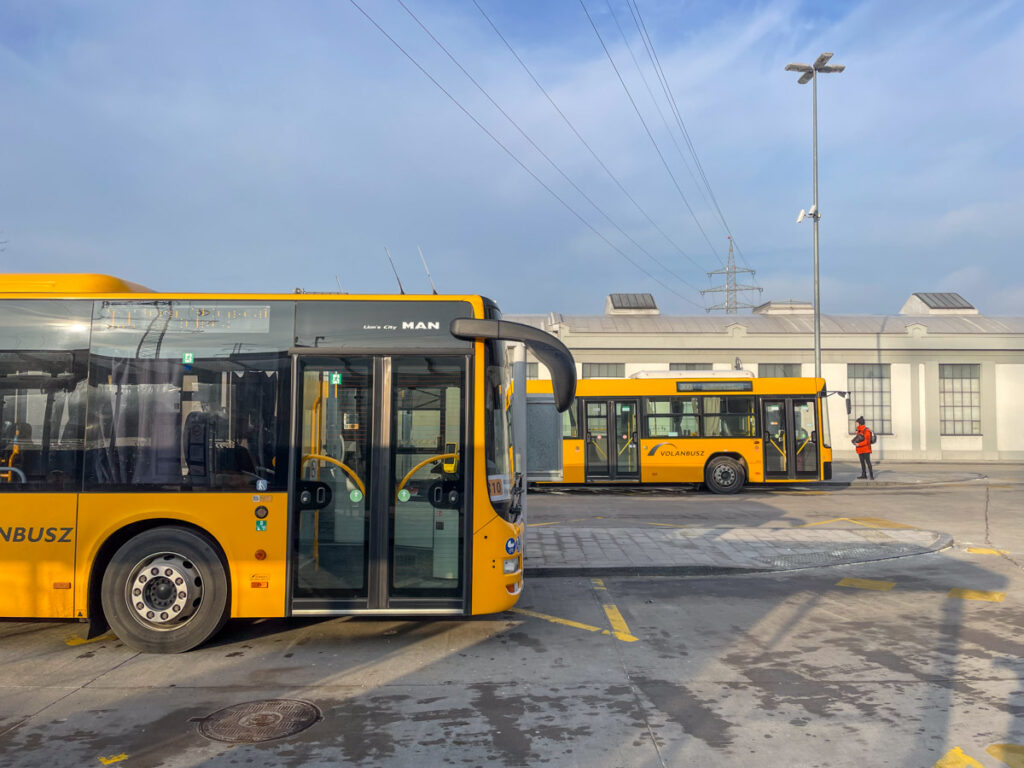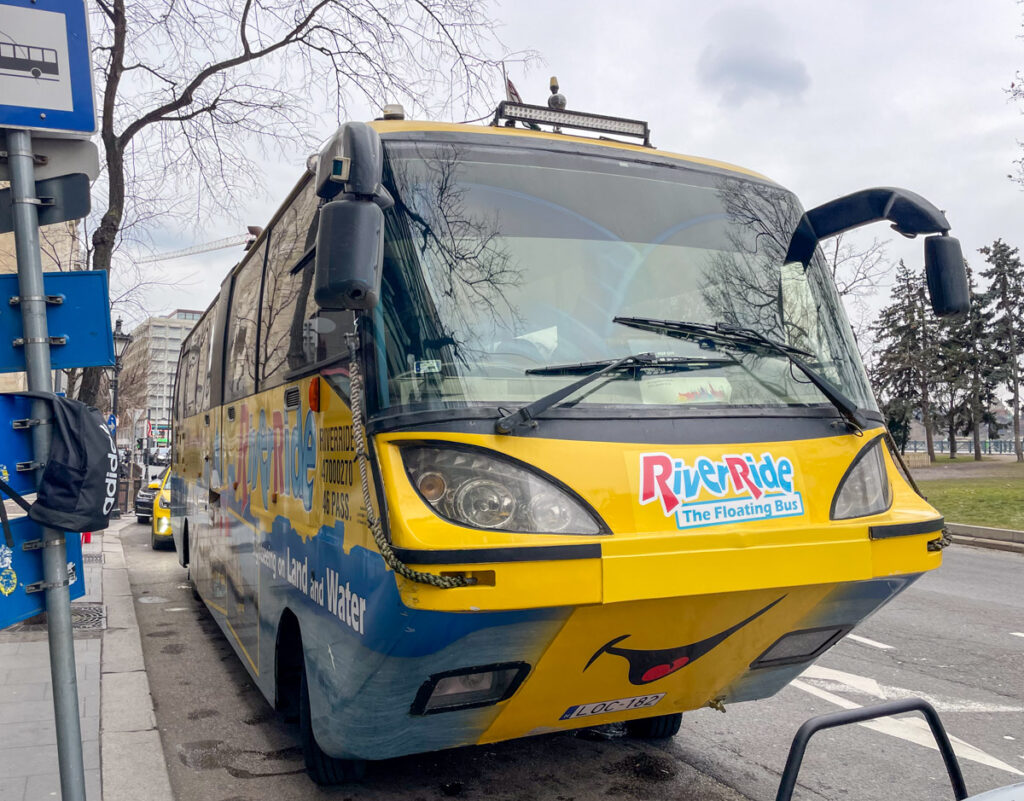Getting around Budapest using its public transport system is quite easy and convenient. You can reach your destination quickly and effortlessly without needing a taxi, and with minimal transfers. While most of the city centre’s attractions are within walking distance, knowing how the public transport system operates is always helpful, especially if you want to reach Margaret Island or the top of the Buda hill to explore the Buda Castle District.
Table of Contents
How to get to Budapest from the airport
If you are looking to travel from Liszt Ferenc Airport to the centre of Budapest, there are a few options available. You can choose to take a bus, taxi or minibus, runned by MiniBUD company. The easiest way to travel is by taking the 100E Airport Express bus. It takes about 30-40 minutes, depending on traffic. You can purchase the ticket on board, which costs 2,200 HUF (around €6). The ticket is valid for a ride from the arrivals terminal to Kalvin Square or Deak Ferenc Square, two places in the centre of Budapest.
PLAN YOUR TRIP TO BUDAPEST
Unlock the best of Budapest with the Budapest Card and enjoy free public transportation, access to the best museums, and relaxation at the famous Lukács Thermal Bath. For more info, read my review of the Budapest Card.
The best way to stay connected in Hungary is with a Holafly eSim, saving real money on data coverage. Finally, ensure your travels are worry-free by getting Heymondo travel insurance for essential peace of mind.
Alternatively, you can take the 200E bus from the airport, then change at Kőbánya-Kispest station and take metro line M3 towards the city centre. The travel time is around 45 minutes to 1 hour, depending on your final destination. The 90-minute ticket you can buy for this journey costs about 750 HUF (€2).
Another option is to take a taxi, which can cost around 10,000-12,000 HUF (€25-30). Just ensure that the cab has a functioning taximeter, as some cases of overcharging have been reported. To be sure to book a legitimate taxi for your transfer from/to the airport, you can use Kiwi Taxi.
In Budapest, there is also a shared minibus service called MiniBUD. Still, depending on your destination, it is not much cheaper than a taxi. The price on the advertising is from €6 but you try a simulation on their website to go to the city centre, taking a taxi may be more cost-effective.
How to get around Budapest by public transport
Getting around Budapest by public transport is a convenient and inexpensive way to explore the city. The city has an extensive network of buses, trams, and metro lines that operate daily from early morning until late at night. Budapest’s public transport system is reliable, efficient, and a great way to see the city’s sights.
Metro
The Budapest metro has four lines, each recognisable after a colour: M1 yellow, M2 red, M3 blue, and M4 green. Every line has its own story, reflecting the country’s political and social events. The metro can reach most of Budapest’s attractions.
The M1, opened in 1896, is the oldest underground railway in continental Europe (if we include the islands, London’s metro system holds the record). Travelling on the Metro Line M1 is a unique experience. The trains are small and simple, perfect for serving the short platforms. Some stations have retained their late 19th-century decorations.
This line has been constantly used since 1896 and is known locally as a kisföldalatti, the small underground. If you want to learn more about the M1 line, you can visit the Underground Railway Museum, a small museum located at the Deák Ferenc tér metro station.
The M2 and M3 lines, on the other hand, were built during communism. M3 is the longest line in Budapest, with 20 stations, measuring 16.5km long. Metro Line M4 is the newest addition to the Budapest system. It opened in 2014, has huge spaces, especially compared to the cramped M1 line, and is automatic and completely driverless.
Tramways
The tram is another excellent mode of transport for exploring Budapest and catching a glimpse of some of the city’s landmarks. The city has 40 different tram lines, and they operate from 4:30 am to 11 pm every day. Although many trams go to the suburbs and others serve commercial and shopping areas, some interest tourists. Tram 2 is ideal if you want to see Budapest’s sights.
Running along the Pest side of the Danube, line 2 provides views of Margaret Island, Parliament, Castle, and Fishermen’s Bastion until Gellért Hill. We came on board the tram 2 in the evening to see all these sights lit up and it was a wonderful experience for just the cost of a single ticket!

Buses and ferries
Buses are another means of transportation you can use to get around Budapest. The city has over 200 bus lines, both day and night. The public transportation network also includes ferries. Ferry lines D11, D12, D13, and D14 zigzag across the Danube. They touch many famous sights and attractions, such as Gellért Hill, the Castle, the Parliament, and Margaret Island.

Where to buy public transport tickets in Budapest
Public transportation in Budapest is affordable, with a single ticket starting at HUF 450 (€1.20). A single ticket is valid for one metro, bus or tram ride, and no transfers are allowed except within the metro.
In addition to single tickets, you can choose between daily tickets, multi-day tickets, and Travel Pass for different durations. The airport bus 100E is never included in public transport passes, you have to buy it apart.
You can buy your tickets on the BudapestGo app, at the automatic ticket machines in the metro stations, or on the bus. If you can buy a single ticket on the bus, you’ll pay HUF 600 instead of HUF 450. Buses don’t accept contactless payment; you can pay by card only at the automatic ticket machines.
However, I recommend to download the BudapestGo app. It allows you to buy any kind of daily tickets, tickets from/to the airport, tickets for multiple people, check the fastest routes, and view available options. Using the BudapestGo app when in Budapest really makes your trip easier.
You can also use the Budapest Pay&GO system to buy tickets with your credit card, smartphone or smartwatch when using the 100E Airport Express bus and the Metro M1. You can purchase a single ticket by tapping your credit card on the Budapest Pay&GO device at the entrance. If you need an invoice or receipt, you can easily access it by logging into the Budapest Pay&GO Customer Portal with your credit card number and expiry date.
Uber and taxis in Budapest
Uber used to operate in Budapest until 2016. Still, due to changes in legislation introduced by the Hungarian government, Uber suspended its services.
Like in other European countries, taxi drivers protested against Uber for not adhering to the same regulations and licensing rules as traditional taxis. Consequently, the Hungarian authorities implemented stricter ride-sharing platform regulations, requiring Uber to comply with the same rules as traditional taxis.
As a result, Uber decided to cease its services in Hungary, including Budapest but recently signed a contract with Főtaxi, so it will restart operations in a different way. However, right now, there are still plenty of great alternatives for getting around Budapest:
- Bolt should be a similar ride-hailing app to Uber, which offers estimated prices before your ride arrives, but it’s basically a taxi. Their cars in fact are yellow like normal taxi.
- City Taxi is a reputable taxi company in Budapest. Almost all the taxis I saw in the city centre were City Taxi or Bolt. Their cars are yellow.
- Főtaxi is one of the largest taxi companies in Budapest, with an app for easy booking.
Taxis in Budapest are yellow with the company name on top or a sticker on the side. I recommend using a reliable taxi service as unlicensed taxis may charge higher than usual fares. The government regulates the taxi fares in Budapest to ensure fairness across the city. The starting fee is 1,000 HUF (€2.90), and the price per kilometre is 400 HUF (€1.15).

Tourist transport in Budapest
When I visit a city for the first time, I love to take a Hop-On Hop-Off bus tour. It’s a great way to explore the main tourist attractions, learn about their history, and see the city while driving around.
One of the most popular ways to experience the city is on a city cruise with a welcome drink on the River Danube. The tour takes you to the main sights of Budapest, and the audioguide will provide you with tourist information while enjoying a glass of Hungarian wine.
The floating bus tour by land and water is an exciting activity for families and kids. You’ll get to see the sights of Budapest from the comfort of a unique coach that drives along busy streets before plunging into the River Danube. Read my review of the RiverRide Floating Bus Tour to discover our unique and fun sightseeing experience.

Budapest Card: Is It Worth It?
The Budapest Card is the official city pass, available in different versions and valid for 24 to 120 hours. It provides unlimited access to public transportation, free entry to the permanent exhibitions of the largest museums, free walking tours, and discounts at restaurants, cafes, baths, and other services. Read my article to discover how much you can save with the Budapest Card.
It can be a convenient option if you plan to visit multiple expensive attractions during the card’s validity period. For example, a Danube cruise and Lukacs Bath are always included in the Budapest Card.
Where to stay in Budapest
Budapest offers a wide range of beautiful hotels to choose from. Hampton By Hilton Budapest City Centre (here my review) is located in the heart of Budapest, just 600 metres from St. Stephen’s Basilica. They offer a delicious breakfast and have a restaurant and a bar on-site. For those looking for a hotel with unique and stunning decor, Stories Boutique Hotel is a 4-star property situated 500 meters away from the Hungarian State Opera. They have a restaurant on-site that serves à la carte, a continental or vegetarian breakfast. If you prefer an aparthotel, Zoya Luxury Residence is an excellent option with units with a coffee machine, a dishwasher, a microwave and parking space.
In conclusion, public transport is an affordable and efficient way to get around Budapest. With its extensive network of buses, trams, metros, and tourist transport, you can easily reach and discover any corner of the city. Feel free to share your experience in the comment section to help the next visitors get the most from their trip to Budapest.
